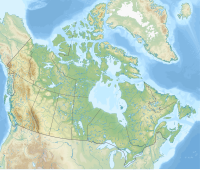Terminal Mountain
| Terminal Mountain | |
|---|---|
 Terminal Mountain seen from The Whistlers. | |
| Highest point | |
| Elevation | 2,835 m (9,301 ft)[1][2] |
| Parent peak | Manx Peak (3044 m) |
| Coordinates | 52°46′42″N 118°09′37″W / 52.77833°N 118.16028°W[3] |
| Geography | |
| Location | Alberta, Canada |
| Parent range | Trident Range, Canadian Rockies |
| Topo map | NTS 83D/16[3] |
Terminal Mountain is a 2,835-metre (9,300-foot) mountain summit located in Jasper National Park, in the Trident Range of the Canadian Rockies of Alberta, Canada. The town of Jasper is situated 12 kilometres to the north-northeast. Terminal Mountain forms the west buttress of Marmot Pass, and the east buttress is formed by Marmot Mountain, home of the Marmot Basin alpine ski area. Circus Valley lies at the south side of the mountain, and the north side towers above the valley of Whistlers Creek. Its nearest higher peak is Manx Peak, 2.0 km (1.2 mi) to the west.
History
The descriptive name Terminal was applied in 1916 by Morrison P. Bridgland (1878-1948), a Dominion Land Surveyor who named many peaks in Jasper Park and the Canadian Rockies.[4] It appeared as Mt. Terminal, 9300 feet, in a 1921 book, "A Climber's Guide to the Rocky Mountains of Canada."[2] The mountain's present name was officially adopted in 1951 by the Geographical Names Board of Canada.[3]
Climate
Based on the Köppen climate classification, Terminal Mountain is located in a subarctic climate with cold, snowy winters, and mild summers.[5] Temperatures can drop below -20 °C with wind chill factors below -30 °C. Precipitation runoff from Terminal Mountain drains into the Athabasca River.
See also

References
- ^ Opentopemap.org
- ^ a b A Climber's Guide to the Rocky Mountains of Canada, Howard Palmer and J. Monroe Thorington authors, American Alpine Club, First Edition, 1921, page 152
- ^ a b c "Terminal Mountain". Geographical Names Data Base. Natural Resources Canada. Retrieved 2017-12-01.
- ^ Place-names of Alberta. Ottawa: Geographic Board of Canada. 1928. p. 124.
- ^ Peel, M. C.; Finlayson, B. L. & McMahon, T. A. (2007). "Updated world map of the Köppen−Geiger climate classification". Hydrol. Earth Syst. Sci. 11: 1633–1644. ISSN 1027-5606.
External links
- Weather forecast: Terminal Mountain
- Parks Canada web site: Jasper National Park


